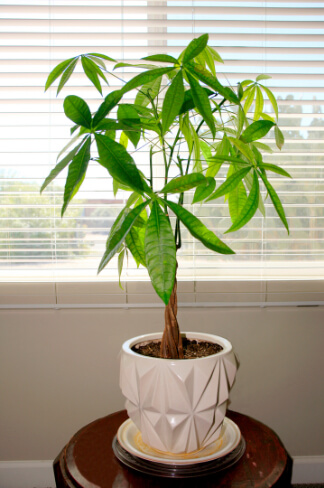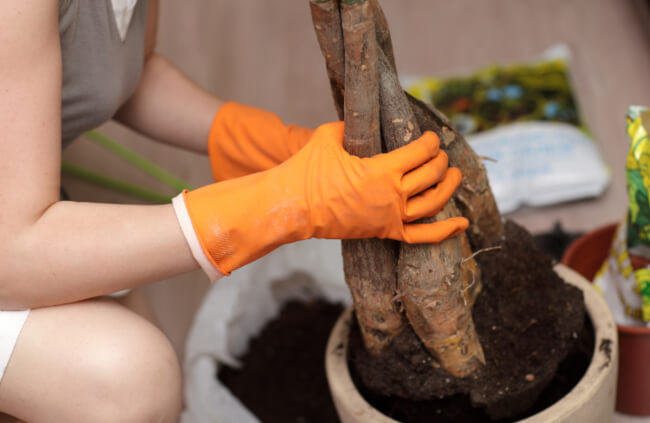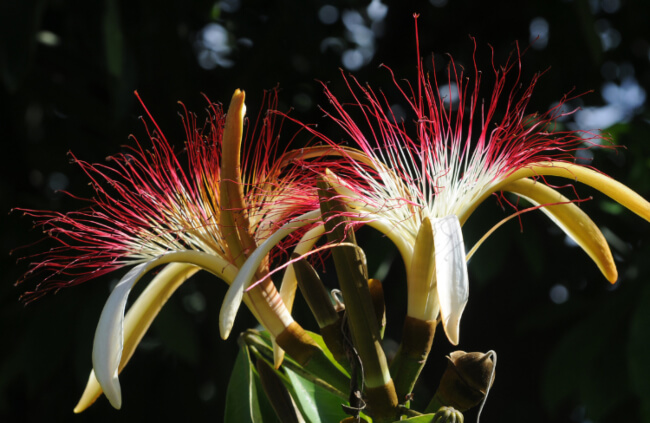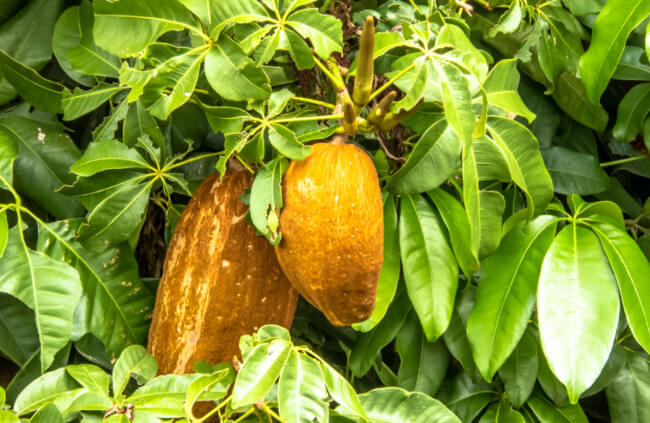Money trees are an excellent option if you’re looking to add some indoor foliage. This broad-leaf evergreen is a popular plant and comes in a variety of sizing, from a bonsai desktop version to a taller, palm-like tree.
Not only is it low-maintenance, but this gorgeous grower is absolutely non-toxic and pet friendly, making it ideal for anywhere in your home. Here is everything you need to know about growing and caring for a money plant tree at home, from cultivation to care.
More...
Getting to Know Money Trees

The Pachira aquatica, more commonly known as a money tree, is a stunning tropical tree originally native to Mexico (similar to Poinsettias) and northern regions of South America. These days, you’ll find money trees just about anywhere.
They’re also particularly popular in Asian countries, like Taiwan. Most noticeable by their braided stems and palm-like leaves, these gorgeous evergreens are a great way to add a tropical feel to your home.
In many cultures, money trees are believed to bring positive energy, good luck and financial success. In their natural habitat, however, money trees don’t quite resemble the cultivars we see indoors.
In the wild, money trees can grow as much as 60 feet tall and don’t have the curious braided stems, making them such an attraction for homes today.
The fruits are sizeable, egg-shaped woody capsules, measuring about 30cm by 13cm wide. As they mature, they turn brown and split open to disperse edible seeds, which have a flavor reminiscent of Castanea sativa (Sweet Chestnut) or peanuts.
Money Tree Varieties
The most popular money tree varieties of money trees to grow indoors include:
- Guiana Chestnut
- Malabar Chestnut
However, there are also two other types of money plants. Jade plant and Chinese money plants are also 2 very popular money plant varieties.
- Jade Plant - Jade plants, or Crassula ovata, are a South African succulent-like plant. It is a smaller growing tree with thick, fleshy leaves.It’s ideal for outdoor growth or spots that receive plenty of sunlight. It is also mildly toxic to pets.
- Chinese Money Plant - Pilea peperomioides, is a popular plant originating from South China. It’s a well-known air purifier and a trusty indoor companion.
What is a Money Tree Good for?
Money trees are not only popular because they’re believed to be luck bringers. Money trees can add vitality and a tropical feel to any indoor space, whether it’s in your home, office or retail space.
Plus, according to NASA’s research, money trees are one of the best-known air-purifiers, filtering many harmful pollutants. Some have even said that money trees can reduce stress, alleviate anxiety, improve mental well-being, and assist with sleeping disorders.
How to Grow Money Trees in Australia
Money tree plants are fairly easily propagated and cared for, as long as it’s given the right conditions. As they don’t need direct sunlight and enjoy a decent amount of humidity, they do exceptionally well indoors.
When it comes to soil, money trees are perfectly happy with any standard, balanced potting mix. They do best with a soil pH level between 6.0 and 7.5.

Propagating Money Trees
Propagating money trees is easiest from a stem cutting and will only take about 4 weeks to root. To propagate, simply:


Get Your Free Guide:
Master Growing Australian Natives eBook
A Must Have Complete Guide for Every Australian Garden
Get Your Free Guide:
Master Growing Australian Natives eBook
A Must Have Complete Guide for Every Australian Garden
- Sterilise your pruning shears, and remove a stem cutting with at least two healthy nodes.
- Dip the stem cutting into a rooting hormone, then stick into a regular potting mix.
- Leave your cutting in a warm room, giving it plenty of indirect light. Mist it regularly to keep the soil moist.
If you cultivate your money tree plants in particularly arid conditions, consider creating a humidity tent using a plastic bag and some chopsticks. The tent will help retain moisture and support root growth.
Sunlight Preference
Money trees do need a decent amount of medium to bright, indirect light. Unless it’s a soft, morning light, direct sun can cause your leaves to become scorched. Keep in mind that these trees grow in tropical conditions and usually grow under other trees’ canopy.
Money Tree Plant Location
Where you place your money tree plants may be dependent on size, as some varieties will happily fit onto desktops, shelves or even windowsills. Anywhere near a south or west-facing window is the ideal spot when it comes to natural light.
Experts also recommend regularly turning your money tree to make sure all the leaves are getting sufficient light.
Money Tree Care Tips

Once established, caring for a money tree is relatively easy, especially if you’re giving it the right amount of moisture. When it comes to watering, you can do so infrequently but make sure that when you water your money tree, the water seeps to the very base.
A good rule of thumb is to drench the soil until the water runs from the bottom. Then, allow it to dry out before soaking again. Money trees like humid environments, so if you’re not growing your money tree in the kitchen or bathroom, consider keeping your pot on a pebble tray or near a humidifier.
Feed your money tree during the spring and summer months with a balanced 10-10-10 fertiliser. Caring for a money tree won’t include much pruning unless you notice a large amount of dead or damaged leaves.
Otherwise, you can leave it growing happily without cutting it back.
Common Money Plant Tree Issues & How to Fix Them
Especially when grown indoors, money trees don't have many problems, and if they do, it’s usually linked to lack of moisture or over-watering. Weakened plants that aren’t getting enough moisture or too much may be susceptible to pests such as scale insects, mealybugs and aphids.
Should you notice a pest issue, simply treat it with a horticultural oil spray or just give a strong jet of water to remove as many bugs as you can.
Final Tips When Caring for Money Plant Tree
- Avoid moving your money tree around too much. They don’t like lots of movement.
- Money trees aren’t big fans of re-potting, so try to keep it in the same pot for at least a few years at a time.
- Keep your money tree away from cold drafts or your air-conditioner or heater.
- If growing outside, be sure to support it with lots of extra humidity and a pebble tray.
- Always use a sterilised set of shears when making cuttings or removing damaged roots and leaves. This will help prevent the spread of disease.
Follow these tips, and you’ll have a happily growing money tree as well as many years of good fortune. Always keep in mind that overwatering can cause a multitude of issues, so less is always more with the money tree unless we’re talking humidity.
Frequently Asked Questions About Money Trees

Why are my money tree leaves turning yellow?
Yellowing of leaves is usually due to a lack of light or overwatering. Be sure to water infrequently and allow the top of the soil to dry out properly in between.
Alternatively, move your money tree somewhere where it can get at least 6 hours of bright, indirect light.
Why are my money tree leaves drooping?
Dropping is another common occurrence and is usually an indicator that your money tree is not getting enough moisture. Boost its humidity by keeping it in the bathroom or near a humidifier and make sure your soil is becoming bone dry.

Wrapping Up Our Guide to Growing and Caring for Money Trees
If you ever feel like your money tree might need a boost, consider keeping it in your bathroom for a week or two. When cultivating new plants, always make sure you’re taking a cutting from a healthy, thriving plant, and if you’re unsure, take a few.
With a balanced potting mix and regular feeding, your money tree should be good to go. Once established, caring for money trees is absolutely easy, and you’ll be able to enjoy this exciting evergreen all year round!
Published on July 17, 2023 by Maisie Blevins
Last Updated on September 20, 2025




